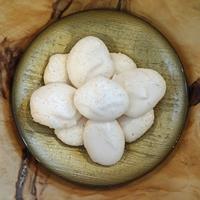This week, after many months of deliberating and skeptically monitoring the activity in the Facebook group “Vegan Meringue – Hits and Misses” I decided to lose my Aquafaba virginity and try making an egg-free meringue. “Can’t be done” I hear you cry. “Aqua what?” you ask. “She’s finally gone bonkers” you say, shaking your head. “It can’t be done.” But wait! It CAN be done. Meringues without eggs, made with the water from a can of chickpeas (yes, that says “a can of chickpeas”) otherwise known as aquafaba. This protein-filled liquid can be whipped up in the same way as egg whites, with surprisingly delicious results.
Before you throw your hands in the air and call me a genius, let me be clear about this. The discovery of this weird and wacky way to use the liquid from a can of chickpeas was not my own. I’ve made other discoveries of considerably less worth during my time on this planet, but I would never, ever, have thought of saving bean-juice and whipping it up with some sugar with the intention of eating it. According to the official website at http://aquafaba.com/ the idea seems to have originated with a french gentleman called Joël Roessel, who “discovered through a systematic investigation into vegetable foams, that liquid from cooked chickpeas and hearts of palm can be whipped into a foam in the same way as flax mucilage. He tested the foam by making a vegan meringue and other desserts, and anonymously shared the results on his blog at revolutionvegetale.com.” This was followed independently by a video called Le Défi FUDA chickpea challenge, released in a few months after Joël’s discovery, in which they whipped chickpea liquid into a foam and added chocolate ganache. Over in the USA a chap called Goose Wohlt was inspired by the French video and found that a stable vegan meringue could be made if the correct techniques were used. He shared his ideas in the Facebook group “What fat vegans eat”, and as a result the group Vegan Meringues – Hits and Misses! was created. And that’s where I come into the picture 🙂 I’ve been watching creative people whipping up edible treats from aquafaba, my eyebrows raised in disbelief, until the day arrived when I said “I’ve really got to try that!”
Chickpeas are eaten regularly in my home, so finding some aquafaba didn’t pose any problems. I searched recipes, tips and tricks, asked questions in the vegan meringue group, and when I thought I had all the conflicting advice I needed I put on my apron and headed off to the kitchen with an air of grim determination. Vegan meringue, here I come!
In my quest for information one thing aquafaba lovers all agreed on was that the bowl, measuring cup and whisk should all be squeaky clean with no traces of fat – wiping them down with vinegar on a piece of kitchen paper was recommended. Chilling the aquafaba also popped up in discussions frequently. But as for the actual how to make a meringue part – that was tricky. Add the sugar at the beginning. No, fold it in at the end. Add it in small amounts during the whipping. Use granulated sugar straight from the bag. Put your sugar in your food processor before using it. Use 1 cup of sugar. 1/4 cup of sugar. The same amount of sugar as aquafaba. Bake at 250’F. Bake at 195’F. Oh boy – I was feeling a bit overwhelmed by the time I got out my whip. Whisk. I mean whisk. My electric hand whisk. Don’t try doing this unaided by the power of electricity…you’ll be there for weeks whipping away.
So, this is what I did. It might not be the best way. It might not be the right way. But the meringues were light and crispy, and broke with a sharp “crack” when I wanted to look inside.
Aquafaba Ultra-simple Meringues
Chickpea liquid from 1 can, about ¾ cup, chilled in a very clean mixing bowl
1 cup white sugar (look for a vegan brand such as Redpath)
An electric hand whisk or stand beater
Line 3 baking trays with parchment paper and heat the oven to 250’F / 130’C / Gas Mark ½. Take the chickpea water out of the fridge and start to beat, slowly adding the sugar in small quantities. Continue to beat for 15 – 20 minutes or until the mixture forms stiff peaks. Scoop the meringue and place the mounds on the baking sheets. and put in the oven for 90 minutes. Don’t open the oven door unless you really have to. When cooked the meringues should be hard to the touch. Let them sit for 10 minutes before serving. They’ll keep for up to 3 days in a tightly sealed container.
So there you have it. This is only the beginning of my aquafaba journey, and I think it’s going to be a fun one. Why don’t you join me? Have a delicious chickpea curry for dinner and follow it with a meringue or two for a wonderful animal-cruelty-free dinner. It will be aquafabalous 🙂
Karen.



I’ve been wanting to experiment with aquafaba since I first heard about it – and finally this afternoon I got round to trying it, using your recipe. Amazing! Can’t believe how simple this is. If you’re interested, I’ve put photos of the results on my Facebook page, enteringveganterritory.co.uk
LikeLike
Hi Karen! 🙂 Since you included a long part of “where does this idea come from”, I thought I’d drop a line- from what I read on some (non-english though) sites, people have been using chickpea or bean water insteat of eggwhite to create “false beaten egg whites” in WW1 already. Like it happens with those “cheap” “shabby” replacements, the idea then was kind of forgotten until recently. 🙂
Greetings
Channly
LikeLike
Thank you 🙂
LikeLike